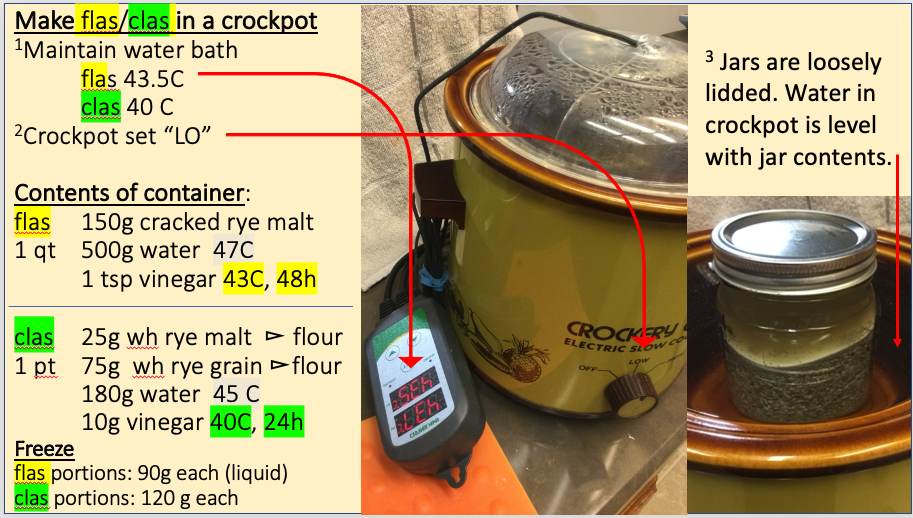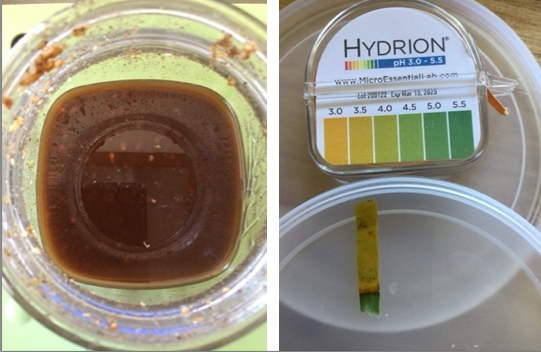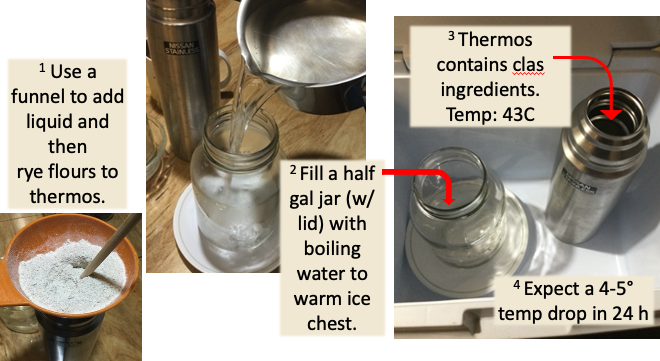Clas, flas and TH-SD are types of sourdough (Type II) used with small amounts of dry instant yeast (DIY) to make bread (often in 4-5 hours).
Refer to the detailed instructions by rusbrot for
- clas here (0:42-6:00);
- flas, rusbot's MALT KMKZ, here;
- TH-SD here. TH-SD stands for thermophilic sourdough.
Summary
To make clas/flas, just mix the ingredients below and place in a jar.
Obtain malt grain(rye or wheat) from a hobby brewing supplies store.
Both clas and flas can be maintained in a water bath in a crockpot with a temperature controller.
Try to match the level of the water bath with the level of the jar contents (clas or flas).
Note that rusbrot emphasizes the use of plastic film on the surface of clas to inhibit mold growth.
This is not needed for flas since the liquidy contents of the jar may be shaken up a couple of times a day.

(Note that a water bath might be maintained in a proofer also. )
Using clas/flas
Strain out the grain sediments in flas mixture; flas (for use in bread dough) is the liquid portion that is left.
Both clas and flas can be used immediately.
Refrigerate clas for 1-2 days and use as if fresh; flas can refrigerated for a week or more.
FREEZE portions of clas(120g)/flas(90 gr) for later use. You will have sourdough at your fingertips!!
(See below for THERMOS Method.)
==============================
Refresh rye CLAS rus brot - https://brotgost.blogspot.com/2018/11/3.html
-No need to add vinegar or use a plastic film to cover surface of clas mixture.
General Proportion: (#gr rye in clas) : (new rye flour) = 1:9
Recipe: Mix the following and ferment at 38-41C , 12 hrs.
29 g Clas (10 g rye, 19 gr water) - room temp
90 g whole rye flour (preferably freshly milled)
171 g(ml) water (45C)
Hydration: 190% Yield: 290 g rye clas
******** Proportions for Refreshment in 6-8 hr: (#gr rye in clas) : (# gr new rye flour) = 1:2 Recipe: 29 g Clas; 20 g whole rye flour; 38 g(ml) water; Yield: 87 gr clas
==============================
Wheat Clas (24-36h)
Recipe: Mix the following and ferment at 38±2C, 24-36 hrs.
-Use plastic film on surface of wheat clas mixture during fermentation. Ending pH-4.
25 g whole grain wheat malt flour (buy malt grain from a brewing supplies store)
75 g whole grain wheat flour
10 g(ml) vinegar (5% acidity)
140 g(ml) water (45C)
Hydration: 150% Yield: 250 g wheat clas
Refresh wheat CLAS (12 hrs)
-No need to add vinegar or use a plastic film to cover surface of clas mixture.
General Proportion: (#gr wheat in clas) : (#gr new wheat flour) = 1:7
Recipe: Mix the following and ferment at 38±2C, 12 hrs.
30 g wheat Clas (12 g wheat, 18 gr water) - room temp
84 g whole wheat flour (preferably freshly milled)
126 g(ml) water (45C)
Hydration: 150% Yield: 240 g wheat clas
==============================
Thermophilic Sourdough Starter with fermented rye malt (solod)
Refer to ingredients and procedure by rusbrot. Makes 250 gr.
- 40 g crushed unfermented rye malt
- 10-15 gr fermented red malt (solod)
- 200 ml water at 60C 400% hydr (200:50) | rye | H2O | H2O | H2O | H2O |
Ferment: 24-30 hr; 50-53C (use a water bath); shake or stir mixture periodically.
Result: flavor like apple/plum

Uses
Recipes by rusbrot using thermophilic sd starter-
==============================
SERGEY's 4 Day Clas
The recipe for Sergey's clas is at foodgeek (see also his Live Journal article).
It is a 4-5 day process.
To refresh takes 24 hrs at 40C.
Mix 50 gr clas with 180 gr ground rye and 270 gr water at 42C.
Hold it in a water with a temperature controller at 40-42C.
(You can also use a proofer.)
It may take 48-60 hr to get the plum fragrance and the reddish tinge.
See the crumb for 100% lean whole wheat loaf here.
==============================
In the lean 100% whole wheat loaf baked in the Zojirushi in a 2000ml Pullman pan, the following amounts were used.

Range for rye flour from above sourdoughs:
clas: 8% (above table)-12%; for Predough-3%
flas 18.9% (above)-28%
TH-SD: 5% (above)
==============================
THERMOS METHOD for making a "modified clas"- the hydration is 300% (cp to 190% in rusbrot formulas).

- Warm a thermos with 50C water for 15 min. Empty it.
- Pour 290 ml of 45C water and 10 ml of vinegar into thermos.
- Use a funnel to add rye flours (75g whole rye and 25 gr wh wheat malt, both freshly ground).
- Close thermos and shake vigorously to mix flour and water-no lumps.
- (Optional- Set thermos in an ice chest with a large jar of boiling water.)
- Shake the thermos about every 8 hr.
- Check for pH < 4 in 24 h.
Keep in mind that the hydration of this "clas" is 300%. | rye | H2O | H2O | H2O |
If a recipe of 500g total flour contains 10% rye flour from clas (50 gr), then 200 gr of "modified clas" is needed to supply 50 gr. rye; the liquid supplied is 150 gr. Adjust total hydration accordingly.
A refresh using the thermos would only require 12 hr.